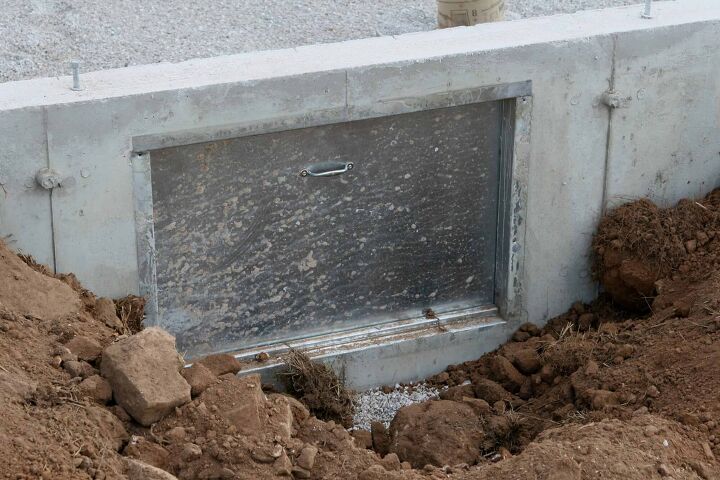What Are Acceptable Moisture Levels In A Crawl Space?

If you’re renting or owning a home with a crawl space, it comes with its fair share of needs. It’s not uncommon for new homeowners to disregard the crawl space, but there are certain things you need to know. For example, you need to be aware of the acceptable moisture levels in a crawl space.
The acceptable moisture levels in a crawl space are between 30% and 50%, with under 55% being the ideal. Moisture levels in your crawl space that go beyond 70% lead to mold growth and health concerns. You can use a dehumidifier when you need your crawl space drier, but it’s essential to maintain proper moisture levels as much as possible.
Whether you have too much water in your crawl space or are just looking for ways to keep it stable, you’re in the right place. Below we’ll discuss proper levels, how to reduce moisture, and what causes them to rise in the first place.
Acceptable Moisture Levels In A Crawl Space
Maintaining proper humidity in a crawl space comes with a lot of benefits. A level between 30% and 50% keeps the air healthy for most households. There are a few things to be aware of if the humidity is too high or too low in the crawl space.
Issues When You Go Below Acceptable Moisture Levels In A Crawl Space
You might think your crawl space being too dry isn’t too big of a deal. But, when the area drops below 30% humidity for an extended period, it can actually lead to drying out your wood. When the wood dries out, it can lead to weakening your home’s structural integrity.
Luckily, it’s difficult to get moisture levels in a crawl space that low unless you’re using a dehumidifier in a really dry area. The more likely issue is that the acceptable moisture levels in the crawl space reach higher levels.
Issues When You Go Above Acceptable Moisture Levels In A Crawl Space
Why Is There Water In My Crawl Space?
It can be frustrating finding that the crawl space in your home has too much water. If you don’t know how it got there, you might find yourself wondering how you can fix it. There are a handful of common reasons homeowners experience excessive humidity under their house.
Bulk Water Issues
If you go into your crawl space and see several inches of water, this is considered a bulk water issue. The two main causes of this are plumbing leaks and drainage issues. If there is improper sloping on the ground outside your home, this is likely the culprit.
For starters, avoid buying a home with a yard that slopes towards the house. The yard should always decline away from the home at a grade of at least 5%. If you find yourself with this issue, you could build a retention wall to prevent water buildup.
Outdoor Air And Crawl Space Vents
It’s not uncommon for a homeowner to not be aware of how important vents are to a crawl space. If you find yourself with extra humidity, the vents may not be used properly. Some say that crawl space vents are outdated, but I think they can still get the job done.
If you’re using crawl space vents, they should be adjusted seasonally, but we’ll talk more about that later. As long as you’re doing this, they’ll keep the humidity under control.
Wet Insulation
As mentioned before, moisture in the crawl space can lead to wet insulation. If left unchecked, this wet insulation raises the humidity levels in your crawl space.
How To Maintain Acceptable Moisture Levels In A Crawl Space
There are a few different ways you can keep your humidity levels in check when it comes to the crawl space. Here are the top three ways you can do just that, even on a budget.
Install A Sump Pump
An option for homes in rural areas is to get a sump pump. A sump pump is a pump in a bucket that’s dug into the ground in the crawl space. When there’s too much water in the air, it will drain into the lowest place and wind up in the bucket.
Then, the pump turns on and drains the water from the bucket. A sump pump should be checked twice a year to ensure everything is working properly.
Use Vapor Barriers
Another way to keep moisture levels under 60% in your crawl space is to use a vapor barrier. This is essentially a thick sheet of plastic that goes over the floor of the crawl space. The plastic creates a barrier that keeps insulation and wood joists dry.
I like to think that vapor barriers are a must in any home with an accessible crawl space. It’s a good idea to have them professionally installed to make sure it’s done right. Vapor barriers also provide clean air for your home.
Change Out Wet Insulation
Use Crawl Space Dehumidifiers
You already know about the amazing benefits that come with using a dehumidifier in your crawl space. It’s the easiest and most cost-efficient way to maintain proper humidity.
A crawl space dehumidifier is installed directly into the crawl space in a specific direction. This allows it to provide the best air circulation possible. It keeps clean air in your home and reduces the chance of harm to the wood support system.
Benefits Of Using A Dehumidifier To Maintain Acceptable Moisture Levels In A Crawl Space
There are several ways you and your family can benefit by controlling the humidity in your crawl space. Below you’ll find the top five reasons many believe come with having a humidity level of 55% or lower in a crawl space.
Health Protection
We all know someone struggling with physical health issues. When you improve the air quality within your home, it’s great for your health. Houses with too much humidity can draw in bacteria, dust mites, and mold.
Using a dehumidifier in your crawl space takes out the moisture from the air that goes into your home. By improving the air quality, you can reduce the symptoms of things like headaches, eye irritations, and respiratory issues.
Pest Prevention
Another benefit of using a dehumidifier in your crawl space is lowering the chances of pests in your house. It’s said that pests, like rats, can cause more damage to a home than severe weather and house fires combined.
I don’t know about you, but setting up a dehumidifier to keep away pests sounds like a great plan.
Improves Your Home’s Structural Integrity
Speaking of damage caused to your home, controlling the moisture in a crawl space can improve the overall structural integrity. When condensation goes above 70%, it can increase the likelihood of wood rot.
This occurs when water touches wood and is most common when there’s at least 28% moisture in the air. When the wood in a crawl space becomes damaged, the wood might not be able to hold up your home.
A dehumidifier will prevent any of this from happening. It’s crucial to have a steady foundation to keep you and your loved ones safe. Controlling the amount of moisture in the air can help ensure your safety.
Provides A Comfortable Living Area
If you’ve ever been in a space that has excess humidity, you know how uncomfortable it can be. It can make you feel hot, sticky, and even sick. By decreasing the air-conditioner temperature, you can help reduce humidity.
But, you can go from hot and stick to cold and clammy when you blast the air conditioner. If you put a dehumidifier in your crawl space, it can control the moisture levels to be more even. This can save you money on your electric bill and keep your entire home at a comfortable temperature.
Acceptable Moisture Levels In A Crawl Space Lead To Energy-Efficiency
Speaking of saving money on your electric bill, using a dehumidifier is an efficient use of energy. It’s a modern instinct to reach for the air conditioning when we’re too hot. It’s common knowledge that running the A/C for an extended amount of time can cost you a pretty penny.
A dehumidifier in your crawl space can reduce the need to use air conditioning. Relative humidity levels should be below 60% for spring, summer, and autumn.
Related Questions
At what moisture content does mold grow on wood?
When the air has a relative humidity of around 90%, it can cause wood to reach a moisture content of about 20%. When this happens, things like mold can grow on wood. Mold feeds on moisture, so the less humid an area is, the less likely, there is to be mold. The ideal moisture content for wood in a crawl space is between 10% and 16%.
Should I open my crawl space vents in the summer?
Crawl space vents allow air from the outdoors to circulate under the floor of your home in the summer. This helps to reduce the amount of moisture buildup that causes things like mold and mildew. In the summer, you should open the vents, and you should close them in the winter.

Kirstin is a passionate writer who loves helping people learn new things when it comes to home improvement. When she's not behind a keyboard, she enjoys DIY projects, crafts, spending time with her pets, and making videos. She hopes that with all she writes, someone is finding a solution to their home improvement needs.
More by Kirstin Harrington
















![10 Most Dangerous Neighborhoods in Baltimore [Updated]](https://cdn-fastly.upgradedhome.com/media/2023/07/31/9075655/10-most-dangerous-neighborhoods-in-baltimore-updated.jpg?size=350x220)










